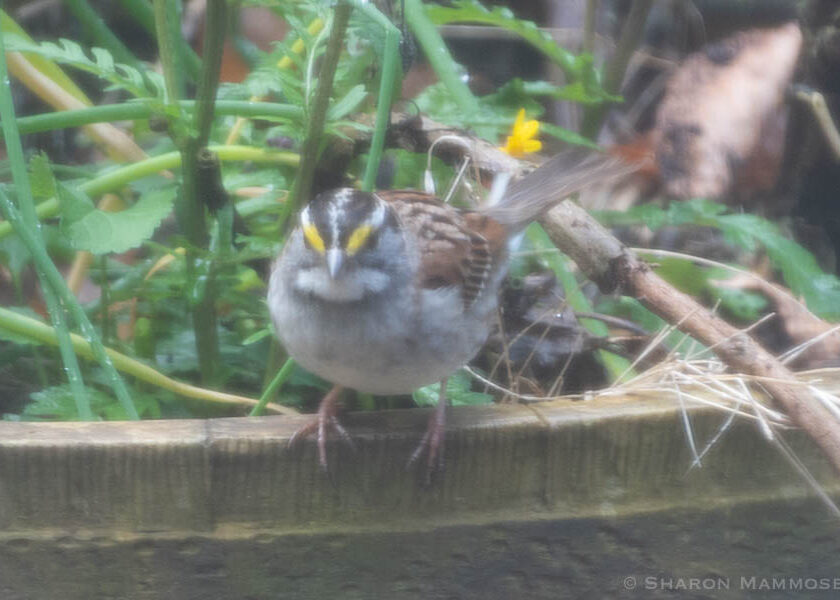The small bird with the yellow and white stripe by its eye and a distinctive white throat from last week’s puzzler is a white-throated sparrow,(Zonotrichia albicollis.) It is aptly named! The yellow spot between its bill and its eyes is called a lore, and both males and females have this. Like some other birds, the white-throated sparrow has two color morphs: sometimes the stripe on its face is tan and others can be white.
You’ve probably heard this bird singing in the forest, as it has a beautiful and distinctive song. The bird books and websites describe it as Peabody, Peabody, Peabody, or Oh Sweet Canada, Canada, Canada. Regardless of which one you think is more correct, this bird has a great song!
White-throated sparrows build their nests in dense vegetation, usually right on the ground. In my yard I am sure this bird has a nest somewhere nearby, as I see the adults just about everyday at the feeder and around in the bushes. Thankfully for the bird, we don’t allow our two cats to roam free as cats will readily find and prey on the eggs or baby birds.
I want to share this fabulous poem about the song of the white-throated sparrow, written by one of my blog subscribers, Murray Palmer, who lives in Canada. Special thanks to Murray for letting me publish his poem!!
Song of the White-throated Sparrow. By Murray Palmer
How spellbinding is the sound created by some tiny avian!
Listen to its ethereal notes chanted from shrubs riparian;
There prominently perched is a white-throated sparrow
Who whistles his shrill, sweet tune like a woodland carol.
It`s a deterrent to competing males, a lure to a potential mate,
And to attentive humans a sign of events that can’t wait.
This bird embodies the boreal forest, its migratory destination.
It compels us to daydream, to let loose our imagination.
I`m in my canoe, quietly paddling on a cool lake or stream …
Leave me alone now; please don`t disturb this lovely dream.
Later the tree canopy closes in with deciduous greenery,
But this species lives near bogs, beaver ponds and open scenery.
One mate is always a white-striped morph, tan-striped its counterpart;
The different crown adornment and behaviour reflect Nature`s art.
With bittersweet acceptance we see the splendid procession of fall.
Does the bird feel likewise in the southward pull of Nature`s call?
It`s the middle of October, and the birds in my yard are busy feeding;
Their internal clocks tell them the warm season is steadily retreating.
The birds sing ever so sweetly but without the enthusiasm of spring,
Though it still pleases me immensely to hear them softly sing.
Will they have enough energy for the risky flight to warmer climes?
Some of us envy their apparent freedom and more carefree times.
But winter will find me watching winter birds, and I`ll still feel mellow,
For in my mind I`m in my canoe, waiting for that white-throated fellow.
And one more from Murray about the white-throated sparrow, in which he talks about how studies have shown that the two color morphs often mate.
Birds Of Different Stripe By Murray Palmer
In coniferous and mixed woodlands there lives a kind of sparrow
Whose song is so melodious it will thrill you to the marrow.
‘Home sweet Canada, Canada, Canada,’ this lovely song,
Vibrant in spring, is flute-like soft when autumn comes along.
But there is something about this bird which makes it unique;
Even if your interest in birds is mild, it’s guaranteed to pique.
The crowns of white-throated sparrows are striped in tan or white.
Both white-striped sexes are aggressive and sing; he puts her to flight.
But white-striped males accept tan-striped females who don’t sing,
Leaving tan males singing, white females to have their yearly fling.
In this unique mating system, pairs are almost always mixed,
Ensuring that an equal white- to tan-striped ratio will be fixed.
By closely observing animals, it never ceases to amaze
How Nature makes things work in most unexpected ways.
More about this in Audubon.org, who says “White-striped males have higher testosterone than tan-striped individuals and tend to be more aggressive; the male white-striped birds also romance more females. Shining in the parental category, tan-striped birds are more nurturing. The two color variants and their specific mating preferences are the result of intriguing genetics that effectively create four “sexes” in White-throated Sparrows: white-striped males, white-striped females, tan-striped males, and tan-striped females.”
Okay, let’s move on to another puzzler, and since we’re on the topic of birds, here’s another for you. It features another songbird–this one with a long tail and a head that’s black… check it out!


